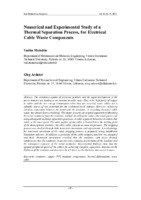Numerical and Experimental Study of a Thermal Separation Process, for Electrical Cable Waste Components

Megtekintés/
Metaadat
Teljes megjelenítés
Link a dokumentumra való hivatkozáshoz:
Gyűjtemény
Absztrakt
The continuous update of electrical products and the rapid development in the
power industry are leading to an increase in cable waste. Due to the high purity of copper
in cables and the low energy consumption when they are recycled, waste cables are a
valuable source of raw materials for the reclaimed metal industry. However, achieving
complete separation between the metal and the insulator, in recycling electrical cable
waste, has always been a challenge. This paper presents an original approach to liberating
the metal conductor from the insulator, without shredding the cables into small pieces and
using subsequent multistep separation processes. A cable is passed between two rollers that
rotate at the same speed. The outer surface of one roller is heated below the melting point
of the thermoplastic insulator; the other roller remains at room temperature. The stripping
process was studied through both numerical simulations and experiments. A methodology
for numerical simulation of the cable stripping process is proposed, using SolidWorks
Simulation software. In addition, a prototype of the cable stripping machine was designed
and built. Numerical simulations revealed that the insulator, with lower thermal
conductivity than the conductor, heats unevenly, resulting in a bending of the insulator and
the subsequent exposure of the metal conductor. Experimental findings show that the
optimal peripheral speed of the rollers for achieving complete separation, depends on the
thickness of the insulator and decreases by 4.5 times, as the thickness increases 1.8 times.
- Cím és alcím
- Numerical and Experimental Study of a Thermal Separation Process, for Electrical Cable Waste Components
- Szerző
- Mokshin, Vadim
- Ardatov, Oleg
- Megjelenés ideje
- 2024
- Hozzáférés szintje
- Open access
- ISSN, e-ISSN
- 1785-8860
- Nyelv
- en
- Terjedelem
- 12 p.
- Tárgyszó
- conductor, copper, PVC insulator, temperature, hermal deformations, waste cable
- Változat
- Kiadói változat
- Egyéb azonosítók
- DOI: 10.12700/APH.21.11.2024.11.5
- A cikket/könyvrészletet tartalmazó dokumentum címe
- Acta Polytechnica Hungarica
- A forrás folyóirat éve
- 2024
- A forrás folyóirat évfolyama
- 21. évf.
- A forrás folyóirat száma
- 11. sz.
- Műfaj
- Tudományos cikk
- Tudományterület
- Műszaki tudományok - anyagtudományok és technológiák
- Egyetem
- Óbudai Egyetem
